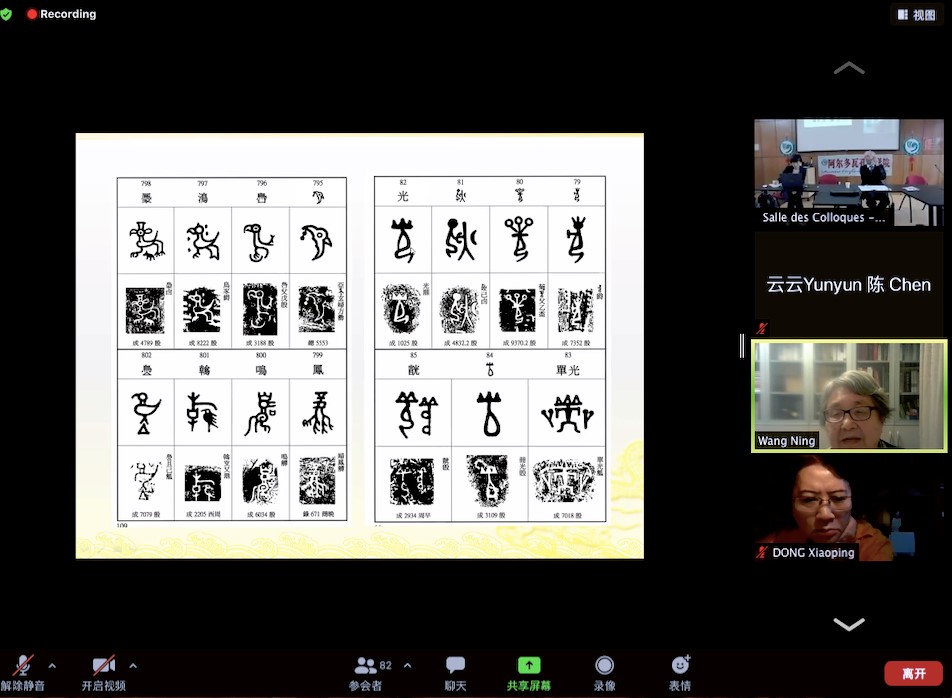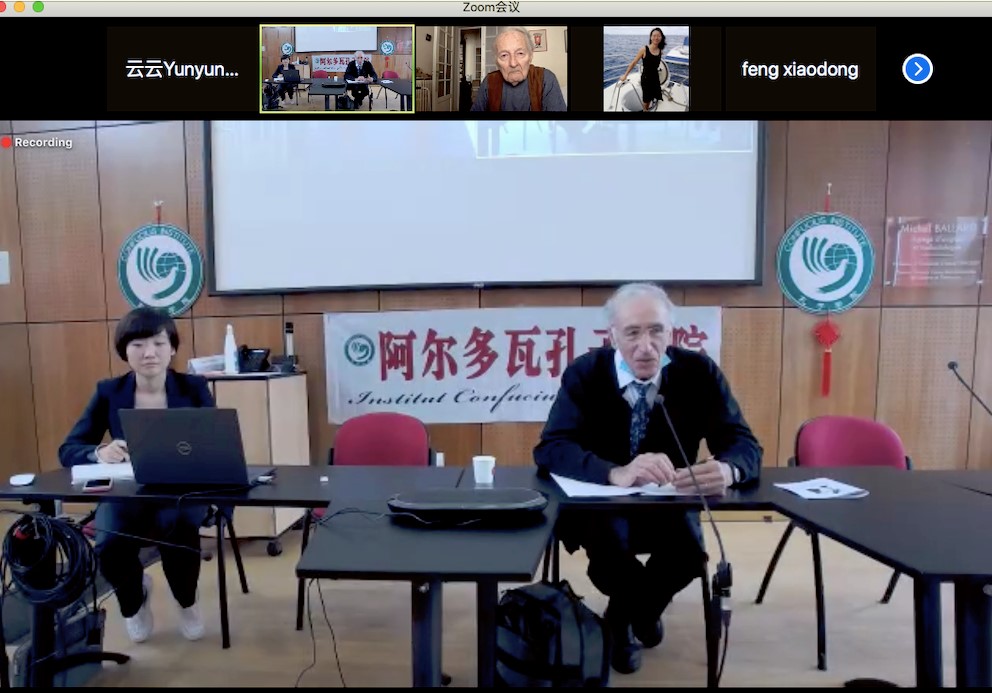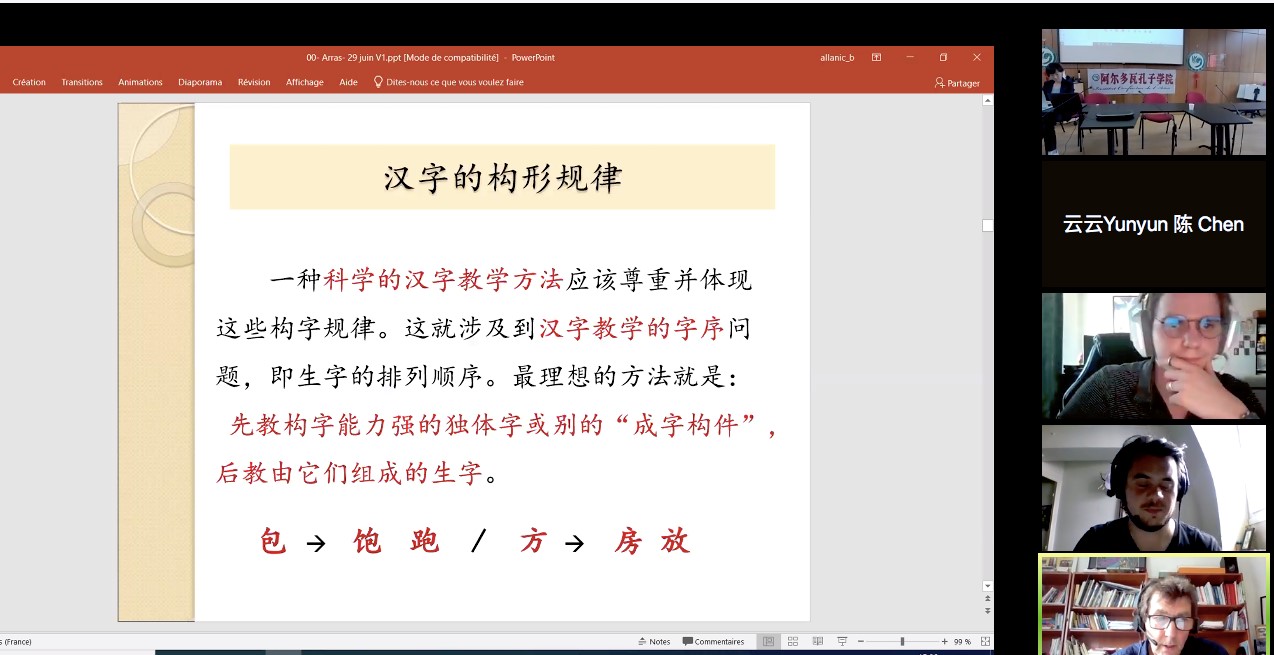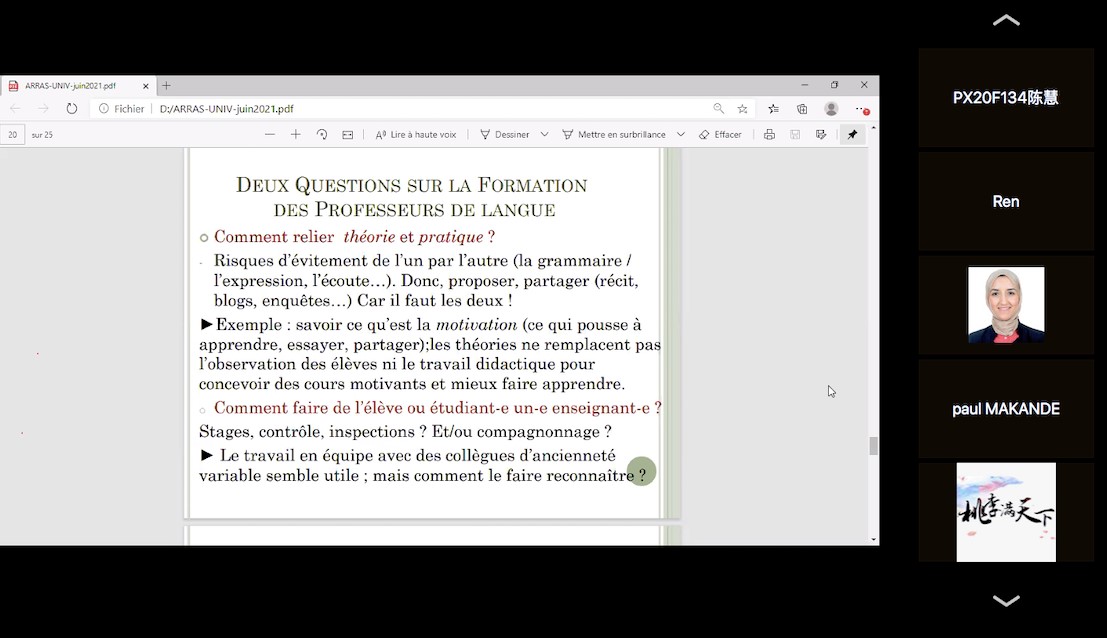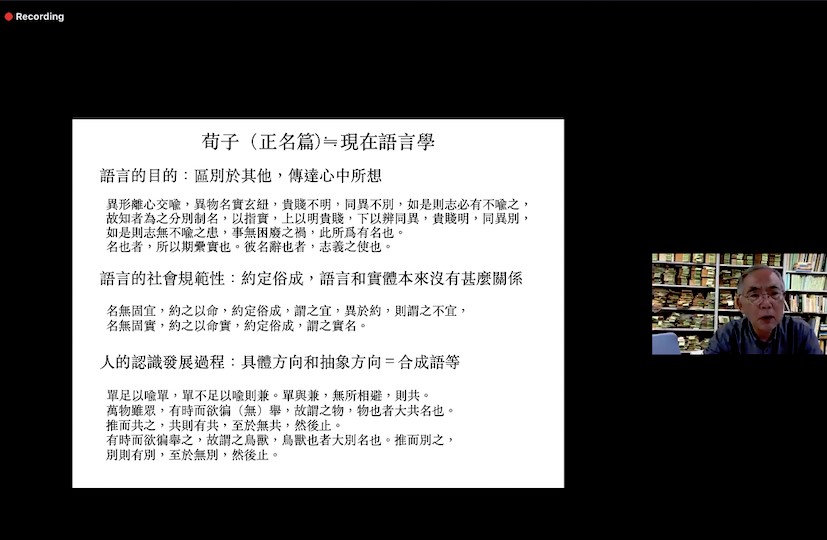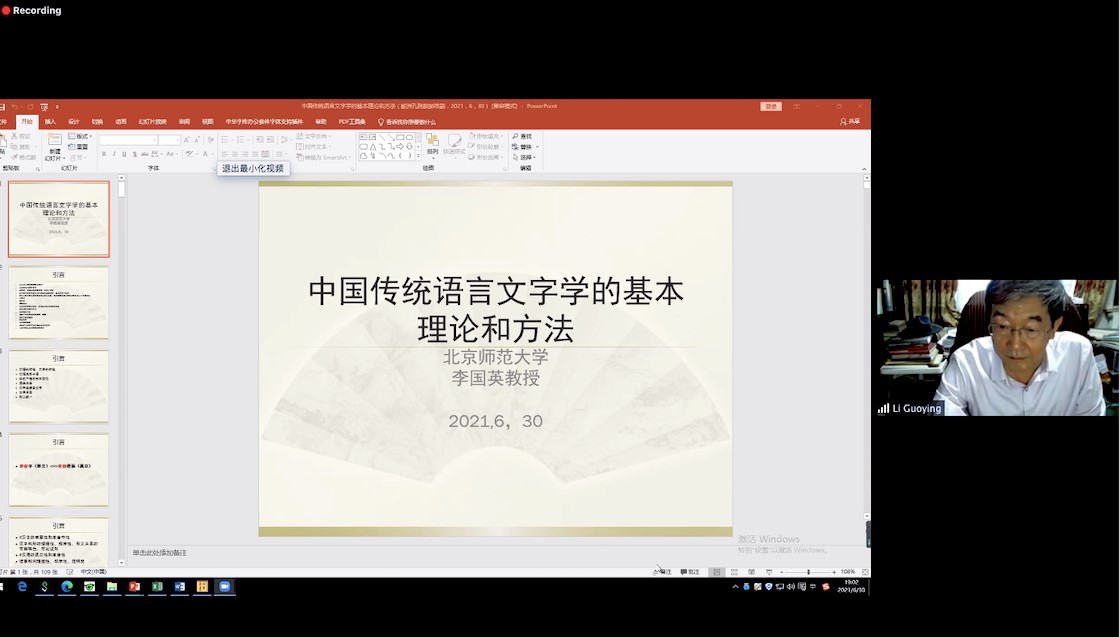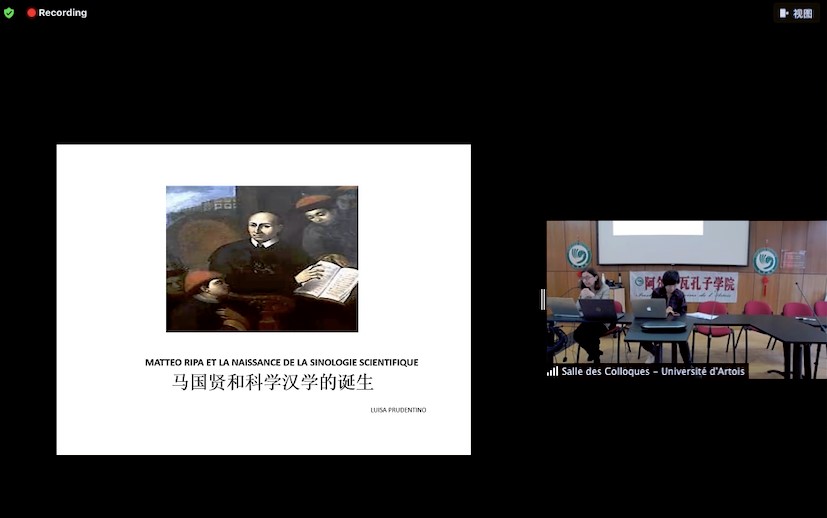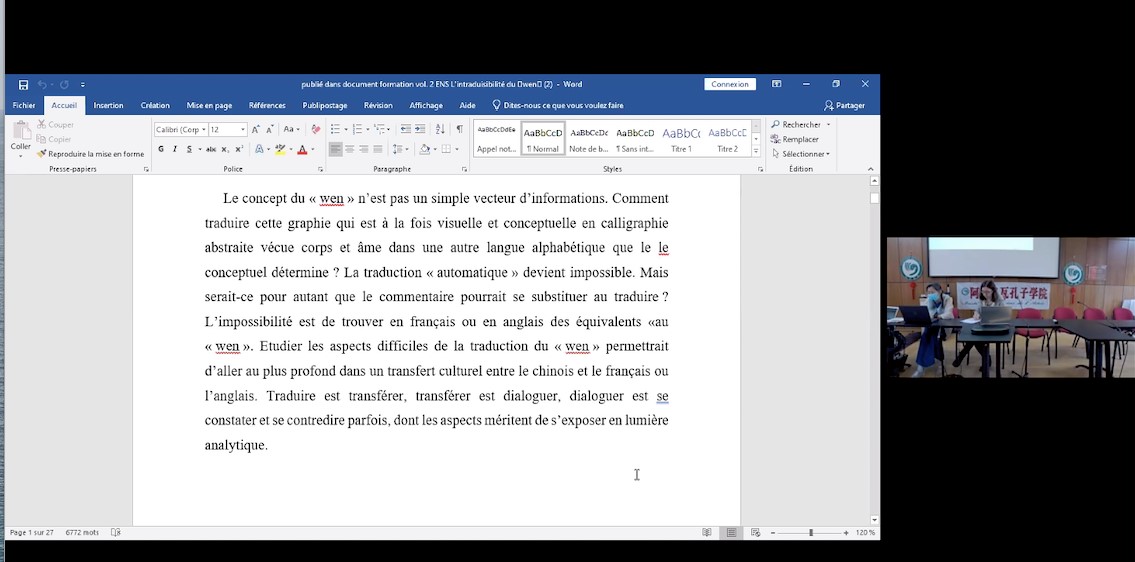
2021年6月29日至30日,阿尔多瓦大学孔子学院成功举办国际研讨会暨第十四届欧洲孔子学院汉语教师与本土教师培训。此次培训采用远程视频直播与线下参与相结合的方式,来自欧亚各国共计94名师生参与。
第一天会议由原法国国民教育部汉语总督学、欧洲汉语教师协会主席、阿尔多瓦大学阿尔多瓦孔子学院欧洲汉语教师培训中心学术主任白乐桑主持。法国著名汉学家汪德迈先生首先发言,阐释汉字的思辨性特征,并为我们讲述言语、语言和文字的关系,特别强调了汉字的文言问题。接下来北京师范大学王宁教授就汪德迈先生的一些观点做出回应并补充证据,通过汪德迈先生对汉语的远距离的视角,摆脱西化立场,反观自己语言文字的真实面貌,使中国语言文字学走向正常发展。白乐桑从中文教育的本体问题一元论和二元论入手,分析了教学中存在的“认识论障碍”。雷恩第二大学安雄(Bernard Allanic)的演讲主题为《汉字与教学的基本单位:基本字和非字构件》,他提出一种科学的汉字教学方法应该尊重并体现构字规律,以构字能力强的基本字带字的方法,同时兼顾口语发展的需要,借鉴集中识字法的经验优化教材中汉字的出现顺序。勃艮第大学 玛丽·乔·贝尔乔德(Marie-Jo Berchoud)教授通过分析普遍的语言,法语,语言的教与学,如何将学生转换成老师,自己的法语教学经验等角度给我们汉语教师的成长与培训提供了有意义的借鉴。
第二天的会议由根特大学巴德善(Bart Dessein)教授主持。日本关西大学内田庆市重点展示分析了古代西洋人的汉语研究特点以及南北官话资料,“从周边看中心”,“旁观者与当局者”的角度给我们研究语言和语言教学提供了新的借鉴与思考。北京师范大学李国英教授展示与分析了传统汉语言文字学的理论与方法。李教授还提出二语教学汉字教育可以吸收传统语言文字学对汉语研究的结果,充分运用已经研究出来的汉字本体的规律以及汉字汉语认知的规律,指导汉字汉语教学。阿尔多瓦大学路易莎(Luisa Prudentino)教授主要介绍了在意大利汉学发展作出卓越贡献的“二马”利玛窦和马国贤,而马国贤更是为科学汉学诞生起到重要作用的关键人物。Luisa老师对马国贤的生平和贡献进行了主要介绍。巴德善梳理了汉学的发展历史以及与西方的渊源。欧洲汉学的发展,并解读了不对称的世界主义,汉学,区域研究与中国研究等问题。阿尔多瓦大学金丝燕教授从对文化转场上的中古汉语《文》的训诂,证明了《文心雕龙》中的“文”的不可译性。
本次培训不仅为我们呈现了语言学,教学论,文化转场中的案例等多重研究视野,还在如何建立论题研究资料框架,如何进入论题研究资料的分析,如何写结论部分以及写出开放性结论等方面提供了方法上的指导,兼具深度与广度。
陈云云
International Seminar and 14th Training for Teachers of Chinese Language in European Confucius Institutes held at Confucius Institute of Artois
From June 29th to 30th, 2021, the Confucius Institute of Artois successfully held the International Seminar and the 14th European Confucius Institute Chinese Teachers and Local Teacher Training. The training is both online and on-site with a total of 94 teachers and students from Eurasian countries participated.
On the first day, Joël Bellassen, the former Superintendent of Chinese in the French Ministry of National Education, President of the European Association of Teachers of Chinese, and Academic Director of the European Training Center, chaired seminar. French Sinologist Léon Vandermeersch first gave a speech, in which he explained the speculative characteristics of Chinese characters, and told us the relationship between parole, language and writing, with special emphasis on the issue of Chinese characters. Professor Wang Ning of Beijing Normal University responded to some of Mr. Vandermeersch's points of view and showed some related materials. Through long-distance vision of Mr. Vandermeersch, we can change the standpoint from westernization to reflect on the true appearance of our own language and its writing in order to enable the normal development of Chinese philology. Starting from the monism and dualism of the ontological issues of Chinese education, Mr. Bellassen analyzed the "epistemological obstacles" in Chinese teaching. Bernard Allanic, professor University of Haute Bretagne - Rennes 2, proposed a scientific teaching method for Chinese characters should respect and reflect the rules of character formation. He also advocated learning more Chinese characters through which are basic and most frequently used, taking into account the needs of oral development,drawing on the experience of “regrouped character teaching” to optimize the order of Chinese characters in a textbook. Professor Marie-Jo Berchoud from the University of Burgundy provided us with meaningful information for the growth and training of Chinese teachers by analyzing the teaching and learning of language, how to turn students into teachers, and her own French teaching experience.
Professor Bart Dessein from Ghent University chaired the second day of the meeting. Uchida Keiichi, working at Kansai University, focused on analyzing the characteristics of Chinese studies in ancient Westerners. The materials of Chinse north and south Mandarin, the perspective "seeing the center from the periphery", and “the spectators and player" provided us with new way of thinking in terms of research on language and language teaching. Professor Li Guoying of Beijing Normal University demonstrated and analyzed the theories and methods of traditional Chinese philology, and proposed us to learn from the research when teaching Chinese as a second language, and make full use of the rules of Chinese characters and cognition for Chinese characters. Luisa Prudentino from the University of Artois introduced Matteo Ricci and Ma Guoxian who made outstanding contributions to the development of Sinology in Italy, and Ma Guoxian was a key figure who played an important role in the birth of scientific sinology, Luisa mainly introduced Ma Guoxian's life and contributions. Professor Dessein combed through the history of Sinology and its connection with the West. The development of Sinology in Europe and the interpretation of asymmetric cosmopolitanism, sinology, regional studies and Chinese studies. Professor Jin Siyan, from the University of Artois proved the untranslatability of "Wen (文)" in "Wen Xin Diao Long (《文心雕龙》)" through analyzing exegesis on the Middle Chinese "Wen (文)" in transculturality.
This training has both depth and breadth, presents not only multiple research perspectives such as linguistics, pedagogical theory, and cases in transculturality, but also a reference for building a framework of research, analyzing data, writing conclusions and even the open conclusions.
Chen Yunyun
Séminaire interculturel et 14ème Formation pour les Enseignants de Chinois dans les Instituts Confucius d’Europe tenus à l’Institut Confucius d’Artois
Du 29 au 30 juin 2021, l’Institut Confucius d’Artois a tenu avec succès le séminaire international et la 14ème formation des professeurs de Chinois des Instituts Confucius d’Europe et locaux. La formation s’est faite en présentiel et à distance avec un total de 94 enseignants et élèves d’Eurasie ayant participé.
Le premier jour, Joël Bellassen, l’ancien inspecteur général de chinois du Ministère de l’Education nationale, Président de l’Association Française des professeurs de chinois et Directeur Académique du Centre Européen de Formation a présidé le séminaire. Tout d’abord, le sinologue Français Léon Vandermeersch a donné un discours dans lequel il a expliqué les caractéristiques spéculatives des caractères chinois et la relation entre la parole, le langage et l’écriture en insistant sur les caractères chinois. Le professeur Wang Ning de l’Université Normale de Pékin a répondu à quelques-uns des points de vue de M. Vandermeersch et a montré des documents connexes. A travers la vision lointaine de M. Vandermeersch, nous pouvons changer le point de vue de l'occidentalisation pour réfléchir sur la véritable apparence de notre propre langue et son écriture afin de permettre le développement normal de la philologie chinoise. Partant du monisme et du dualisme des enjeux ontologiques de l'éducation chinoise, M. Bellassen a analysé les « obstacles épistémologiques » dans l'enseignement chinois. Bernard Allanic, professeur à l'Université de Haute Bretagne - Rennes 2, a proposé une méthode d'enseignement scientifique des caractères chinois devant respecter et refléter les règles de formation des caractères. Il a également préconisé d'apprendre davantage de caractères chinois basiques et les plus fréquemment utilisés, en tenant compte des besoins de développement oral, en s'appuyant sur l'expérience de « l'enseignement des caractères regroupés » pour optimiser l'ordre des caractères chinois dans un manuel. Le professeur Marie-Jo Berchoud de l'Université de Bourgogne nous a fourni des informations utiles pour la croissance et la formation des enseignants chinois en analysant l'enseignement et l'apprentissage de la langue, la façon de transformer les étudiants en enseignants et sa propre expérience d'enseignement du français.
Le professeur Bart Dessein de l'Université de Gand a présidé la deuxième journée de la réunion. Uchida Keiichi, travaillant à l'Université du Kansai, s'est concentré sur l'analyse des caractéristiques des études chinoises chez les anciens Occidentaux. Les matériaux du mandarin du nord et du sud, la perspective de « voir le centre depuis la périphérie », et « les spectateurs et le joueur » nous ont fourni une nouvelle façon de penser en termes de recherche sur la langue et l'enseignement des langues. Le professeur Li Guoying de l'Université Normale de Pékin a démontré et analysé les théories et les méthodes de la philologie chinoise traditionnelle, et nous a proposé d'apprendre de la recherche lors de l'enseignement du chinois comme langue seconde et d'utiliser pleinement les règles des caractères chinois et la cognition des caractères chinois. Luisa Prudentino de l'Université d'Artois a présenté Matteo Ricci et Ma Guoxian qui ont apporté des contributions exceptionnelles au développement de la sinologie en Italie, et Ma Guoxian était une figure clé qui a joué un rôle important dans la naissance de la sinologie scientifique, Luisa a principalement présenté la vie de Ma Guoxian et ses contributions. Le professeur Dessein a passé au peigne fin l'histoire de la sinologie et ses liens avec l'Occident. Le développement de la sinologie en Europe et l'interprétation du cosmopolitisme asymétrique, de la sinologie, des études régionales et des études chinoises. Le professeur Jin Siyan, de l'Université d'Artois a prouvé l'intraduisibilité de « Wen (文) » dans « Wen Xin Diao Long (《文心雕龙》) » en analysant l'exégèse du chinois médiéval « Wen (文) » dans la transculturalité.
Cette formation a à la fois de la profondeur et de l'étendue, présente non seulement de multiples perspectives de recherche telles que la linguistique, la théorie pédagogique et les cas de transculturalité, mais aussi une référence pour construire un cadre de recherche, analyser des données, rédiger des conclusions et même des conclusions ouvertes.
Kevin Stievenart


